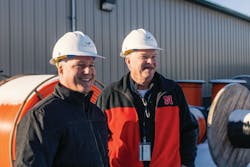Executive Insights with Joe Pellegrini, Chief Construction Officer, Great Plains Communications (GPC)
Topic: Your Challenges
When you were hired, your charge was to develop and implement Great Plains Communications’ Fiber-to-the-Home (FTTH) strategic growth initiative to residential customers in new markets as well as aggressive expansion in current Midwestern markets. Now, it’s evolved a bit to say the least.
ISE: As Chief Construction Officer, what’s the most challenging thing about your job responsibilities?
Pellegrini: It's been terrific having the opportunity to take on responsibility for a larger portion of the business. For me, it always comes down to three main things. Do we have the proper processes in place? Do we have the right systems to support those processes? And does everyone, me included, understand what they're responsible for and how to achieve success?
I'm a huge fan of digitized documentation and mapping. The most challenging part of my job responsibilities now is helping define the processes needed as we grow and morph into a digital and IT-IS centric business while ensuring people are getting trained in the new or refined systems. This allows us to grow the business, purify and digitize more and more records and deliver on somewhat of a changing customer expectation landscape.
Topic: Field Experience
ISE: You were a fiber splicer early on in your career. Why is it important to understand fiber field realities in your role at GPC? What is your recommendation to field techs who want to move into leadership as you did?Pellegrini: As a splicer, having the proper records, understanding the deliverables and being able to be an advocate for the business while standing in front of the customer made an impression on me. Logistically, it’s understanding that weather and where things are located have a huge impact on the crew, delivery, and customer completion schedule. Then safety. We can all look at spreadsheets and move numbers around, but there are larger implications such as people. Now, as an executive, that experience allows me to liaise well between the spreadsheets and growth trajectory, and then the true operational cost, time frame, logistics and safety of implementing those asks in terms of growing a business.
Having spent so much time in the field at a young age has given me a greater perspective on optimizing a business successfully and managing all those different pieces that go into it. Appreciate and learn from where you are at that moment in time. So many people want to grow and run to the next level and hurry up to the next piece of their career or the next job title before truly understanding and becoming an expert where they are. As you move through the ranks by learning and developing those skills, you continue to round yourself out.
Topic: Supply Chain
You’ve said the following about GPC’s supply chain strategy: “We've had to plan appropriately and order earlier, tying up more CAPEX and placing larger orders earlier, so we have a more definable inventory delivery schedule to continue building at pace. The new reality is that what formerly was a three-to-six-month order/delivery window could now be up to a year or more, and we must plan accordingly.”ISE: Define that more specifically using a network-related example.
Pellegrini: The last couple of years have been a challenge with the supply chain. Things that used to require a three-to-six-month delivery window are now pushed much further out. Yet, we sometimes don't know what we need a year or more out in terms of the enterprise. What we do know is our projected growth. We knew we were going to grow fairly aggressively. So, we go to vendors and inquire about the terms of allocations over time, upsizing some allocations and purchasing and buying down earlier to arrive before we need the product.
A specific example is on the FTTH side. We knew we were going to upsize the delivery from late 2022 through 2024, so we went through all the different pieces of a true FTTH construction plan and delivery schedule—whether it's internal office equipment, external customer, prime equipment, or everything in between—and ordered a year or two's worth of inventory. We are now taking delivery of all that.
Topic: Fiber Construction Nuts and Bolts
ISE: What portion of your deployment is handled in-house versus by contractors? Share two best field deployment practices that GPC can teach other network providers to improve time-to-market and reduce cost-per-mile and unit passed.
Pellegrini: We do the majority of our splicing in-house. It's a huge cost savings that allows us to define a very specific practice and policy in splicing and testing. Our operations group does all installations and trouble calls to ensure timely customer delivery and a terrific customer experience.
That’s a little more difficult to do if you're farming out all your work to contractors and vendors. When the customer knows everybody walking in the door on the delivery side has a GPC logo on their ID, it makes a difference in terms of how we define what a customer delivery looks and feels like and what that customer experience should look and feel like.
Topic: Muni Partnerships
ISE: Why should municipalities work with a network provider instead of building their own fiber networks?
Pellegrini: Municipal networks are usually led by a single champion. At a municipality, someone gets hired in town or gets the idea to build their own network and champion their cause. That one person might leave or go to a different job. They may get a different opportunity or retire. Then that municipality loses that single champion.
Long-term budgets are not a given in municipalities. Municipalities must redo and pass their budgets each year. Therefore, if it's led by a single champion, it's got a one-year or bonded budget to build out the network. Then there's debt service associated with that. It's rarely put together in a way that accounts for long-term costs.
Our responsibility is to develop a full solution with a city in a technology partnership that provides the upfront costs, maintenance costs, and upgrade cycles. We work alongside municipalities to help build, own, maintain, operate, market, and deliver services to their community.
Topic: Advocating for Rural Communities
ISE: You’ve done significant work advocating for the needs of communities that are underserved. Share some of the unique challenges you face in terms of network deployments, labor challenges, supply chain and ROI. What can the industry do to help other providers (and you, of course) with those challenges in the future?Pellegrini: On the network deployment side, a growing industry challenge over the past 10 years has been difficulty getting on power and telephone company poles. The amount of make-ready and the time frames associated has changed the makeup of what we used to consider a successful build, which was 80% aerial and 20% underground in many places across the country.
There used to be cost savings associated with going aerial. The higher expenses today and greater difficulties for third parties like us to get access to those poles have forced more of an underground build. The time frames are also forcing a lot of companies to go underground more because we can build underground in many cases much quicker than aerial. For aerial fiber deployments, getting to some of these communities and servicing them effectively has been difficult in terms of network deployment labor challenges.
We’re trying to entice employees to the industry who want to be here and grow with the business by creating an environment they want to stay in. That’s an ongoing culture initiative in continuing to change and adjust to meet external industry demands and challenges. Our initiatives are our advantages when attracting quality employees.
Topic: Fiber Deployment
ISE: Aggressively deploying fiber across rural communities is no easy or cost-efficient task. What are two of GPC's best practices other providers can borrow as they work to connect the underserved in their communities?
Pellegrini: First, because we're a 113-year-old company and we've been building fiber for the last 30 years, we own and maintain a lot of our middle-mile network. This is a differentiator and best practice. By owning that middle-mile network, we pass many underserved communities.
Secondly, we can leverage that existing network asset, put in points of presence along that network and bring those underserved communities online.
When they do come online, we're tapping into a high bandwidth dual feed connection in our already robust middle-mile network. So, it's not that we're building low bandwidth spurs out to communities, but rather utilizing that existing dual path, which helps decrease downtime. These areas are mostly areas where we have successfully built and continue to leverage existing community relationships.
Topic: What Keeps You Up at Night?
ISE: What is the ONE item that keeps you up at night?
Pellegrini: People. An extremely important part of the business is developing the parameters where employees can come and put in the quality effort at work, but also disengage appropriately and put the quality effort into other things in their life that fills their cup, whether it's family, exercising, reading, etc.
Topic: Your Forecast for 2023
ISE: What’s your crystal ball saying will be most important to the success of Communications Service Providers (CSPs) in 2023?
Pellegrini: Smart deployment of capital. The cost of capital has risen so much with the rise in interest rates. Debt service will be a huge drag on the company's bottom line if capital is being deployed without a real understanding of the time frame for the return on investment.
Topic: Operational Realities and Proactive Network Management
ICT industry analysts and observers often focus on CAPEX budgets. But the reality is that OPEX can make or break the bottom line. The key to controlling OPEX is improving network life cycle management for complex fiber, and legacy networks in a cost-efficient manner.
ISE: How will GPC ensure the networks it deploys are maintained in an operationally efficient manner? What are some proactive approaches you recommend to control OPEX?
Pellegrini: We have an extensive existing fiber footprint that continues to grow. It has been built over the years in a very managed way with an eye for high quality and redundancy. We can deploy and maintain the network efficiently because we engage local vendors, contractors, and employees in our markets. We take pride in the assets and the customer experience associated with them.
For GPC, controlling the operational expenditure side and improving network lifestyle management for complex fiber and legacy networks is difficult. To truly maintain and spend the money on maintenance, as well as upgrading, must be done in a thoughtful and managed way over a longer term. We can't just look at a network and in 12 months, fix, change, and upgrade everything. It must be done as a priority based on constraints with the network, the needs of the customer, or general equipment life cycles.
Topic: Retaining and Retraining Top Talent
The great resignation is not ending. How does your team hold onto professionals with the most talent and the greatest work ethic when they must upskill to remain relevant? (Oftentimes, “upskilling” translates into working their day job and at the same time learning new skills for the future.)
ISE: Share your thoughts about the “rub” of this reality to employers AND employees.
Pellegrini: As an executive, I’ve been spending a lot of time on the upskilling subject. We have found in multiple employee surveys that employees in the five to seven service year range seem to be the most at risk. The reason tends to be that they’ve been in the business or doing a job long enough to become extremely proficient. Yet, if the time and energy aren't spent with them to help them continue to learn and grow, they stagnate. These people have extremely marketable skill sets and can go find other opportunities. It is important for businesses to not only understand that but also take action to retain and grow employees.
Any of us who have been doing this for a long enough time realize some of the biggest enjoyment we get out of work is helping, training, and mentoring others who are coming up in their careers and want to learn.
For GPC, it’s recognizing top talent and what they bring to the business, ensuring benefits and flexibility are there, but also providing the opportunity to continually work and improve skill sets, and then share their abilities and skills with others who are up and coming. This creates a true mentoring and team environment that results in successful, happy employees.
Topic: Advice
ISE: What would you tell emerging leaders as they try to make a difference in the industry AND propel their careers to the next level?
Pellegrini: Try not to be everything to everyone. Understand every person, whether it's on the same side of the table or across the table, everyone has different experiences and perspectives and maybe a better way to get things done.
One of the smartest things you can do as a leader is close your mouth and let others express their interests, opinions, or their versions of things. When I do that, I learn something, and it makes me look a little bit differently at a solution. We find better ways with more input.
My biggest advice would be for leaders to learn how to listen and not think that because you have a title you have a right to talk more. Learning to ask questions and listen yields better results in almost every single format.
Topic: Balance
ISE: Is there such a thing as work/life balance? How do you create that? And what is some advice you can give others?
Pellegrini: When I first started back in the day as a splicer, I had a beeper and a company cell phone, which was my first experience with 24/7, 365 access to work. I have struggled, as many others have, with what true work/life balance looks and feels like over the years, especially earlier in my career when I was on call and had to be actionably ready to leave and go help with something.
Now, as a leader, really defining for my team what that feels like in terms of requiring a level of effort at work, and then allowing folks to disengage in a meaningful way once they're off the clock, helps to create an employee that doesn't feel always on because always on equals burnout over time. My advice to others is try and have fun at work. Remember that we spend so much time with each other at work that creating an enjoyable environment starts with you as a leader in any function.
Topic: The Elephant in the Room
ISE: What is the industry NOT addressing that it should related to network evolution and broadband for all.
Pellegrini: The practice of building sustainable businesses. Businesses are being built right now that are trying to get as many passings as possible in the shortest amount of time to monetize and sell the asset. We need to ensure companies are building sustainable, customer-focused businesses with a quality network committed to long-term viability as opposed to a race to sell and monetize.
ISE: Share one problem/challenge you are passionate about solving for the broadband industry.
Pellegrini: At GPC, we are passionate about providing service to everyone. There is no one passion because we are committed to a wide range of serviceability to our customers. All our initiatives take priority with a distinct place within our company. Our job is to fill the gaps in the industry with our unique approach as a leading digital telecommunications provider.
Topic: Honesty
ISE: How much of your success comes from luck or coincidence versus grit and perseverance?
Pellegrini: All four play huge factors in anyone's success. Having the ability to persevere with grit and to follow up on difficult and uncomfortable situations is a tremendous differentiator. It also takes some coincidences and a lot of luck to find yourself in a position to prove you have what it takes. It takes people in your career to view you in a way that you didn't realize. Maybe you had an ability and they set an expectation that's above where you would have placed your own. Suddenly you find yourself achieving a success you never knew was possible.
Topic: Community Employment
ISE: Given labor challenges, how does GPC attract, train, and retain workers from the areas it serves?
Pellegrini: GPC offers a terrific culture. I've had the opportunity and the good fortune to work in multiple businesses over the past 25 years. I’ve seen some companies struggle with culture and engagement and others who have worked at it and tried to engage at a high level.
I see GPC working at a high level to engage with a quality culture that they continue to work on and evolve. One example is the early adoption and concurrent maturation of the GPC work-from-home policy. Many companies try to adopt it, struggle, and then try to pull as many people back to the office as they can. We haven’t. We’ve determined this is a successful way to run a business. We trust our employees to do what they need to do when they need to do it. That flexibility is going to help us not just attract, but truly retain long-term real talent to help us grow the business and refine systems and policies. That's a defining factor that we're sticking with.
“Having spent so much time in the field at a young age has given me a greater perspective on optimizing a business successfully and managing all those different pieces that go into it. Appreciate and learn from where you are at that moment in time. So many people want to grow and run to the next level and hurry up to the next piece of their career or the next job title before truly understanding and becoming an expert where they are.”
Topic: Broadband Deployments: Quality, Timing, Scale and Cost-Efficiency
ISE: Can all four be achieved in the future and if so, how will GPC accomplish it? Which is more important?
Pellegrini: It depends on who you ask. Quality and scale are two static points of this question. Quality leads to a long-term asset that is robust and delivers a great customer experience. Scale is based on what the company in question can handle effectively in reference to internal and external funding, people processes, and systems.
Where it becomes a bit murkier is the timing and cost efficiency. Timing needs to take multiple factors into account, from funding expectations, governmental and private capital to competitive factors to general appetite for growth.
Cost efficiency is another very subjective matter. Is there a desired payback? Is it a build-and-hold model or a grow-and-sell model? Both offer very different expectations and calculations on cost efficiency.
We will be growing our FTTH position aggressively where it makes sense, continuing to infill in markets where we already have a presence, and converting our non-fiber customers to fiber. We will do all this while continuing to build one of the highest-quality networks in the Midwest in a way that ensures we are profitable.ABOUT JOE PELLEGRINI
Joe Pellegrini is the Chief Construction Officerat Great Plains Communications (GPC), one of the largest privatelyFor more information, email [email protected] or visit gpcom.com. Visit GPC on Twitter @GPC_updates, LinkedIn: https://www.linkedin.com/company/great-plains-communications/ and Facebook: https://www.facebook.com/GreatPlainsCommunications.
About the Author
Sharon Vollman
Content Ambassador for ISE EXPO
Sharon Vollman is the Content Ambassador for ISE EXPO. She is passionate about collaborating with thought leaders, SMEs and hard-working doers who design, plan and deploy ultra-reliable broadband networks. Vollman is committed to creating a variety of educational offerings for ISE EXPO attendees that inspire them to connect every U.S. citizen with the broadband networks we all want for our children and grandchildren.
Vollman has created educational partnerships with Broadband Service Providers including AT&T, Verizon, Lumen, Frontier Communications and others. She has covered the telecom industry since 1996.






